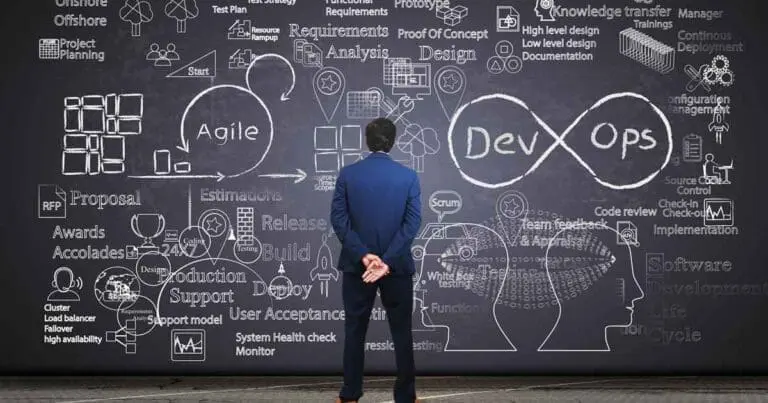Choosing a Software Development Lifecycle Model: Waterfall, Agile & DevOps

Understanding different software development lifecycle (SDLC) models can seem like a daunting task.
From Waterfall to Agile and DevOps, it can be tricky to decide which is the best option for your organization.
Gain a simplified view of the three most common SDLC models and get guidance on how to choose the right model for you.
What is SDLC?
Software Development Lifecycle (SDLC) is a method of creating and maintaining software applications. It involves planning, designing, building, testing, deploying, and maintaining the software throughout its life cycle.
The goal with SDLC is to create a system that meets customer requirements while also optimizing for cost-effectiveness and sustainability.
What are the different SDLC Models?
There are three main SDLC models that organizations can choose from that include the Waterfall model, the Agile model, and the DevOps model.
SDLC Waterfall Model
The Waterfall Model is a sequential software development lifecycle model that emphasizes a structured, linear approach to software development.
It entails following the steps of planning, designing, coding, testing, and deploying in sequence without revisiting earlier stages.
This structured approach allows for more control over the project’s timeline and budget.
Advantages of the Waterfall Model include:
• Comprehensive planning
• Sequential development process
• Clearly defined roles and responsibilities for each stage of the project
Disadvantages of the Waterfall Model include:
• Lack of flexibility and adaptability
• Limited feedback opportunities along the way
• Time-consuming implementation
SDLC Agile Model
The Agile Model is a software development lifecycle model that emphasizes an iterative approach.
It is an adaptive, flexible, and fast-paced methodology that involves breaking down complex tasks into smaller chunks, making them more manageable.
This enables rapid and continuous delivery of software applications in shorter time frames.
Advantages of the Agile Model include:
• Adaptability to changing customer requirements
• Improved collaboration between the development team and stakeholders
• Faster delivery of applications to market
Disadvantages of the Agile Model include:
• Requires strong communication skills across multiple teams
• May not be suitable for long-term projects or larger-scale solutions
SDLC DevOps Model
DevOps is a model that integrates development (Dev) with operations (Ops).
It emphasizes automation, collaboration between teams, continuous delivery of applications, and rapid feedback loops.
Benefits of implementing DevOps include faster deployment cycles, improved communication between teams, and increased customer satisfaction due to better quality products delivered quickly.
Advantages of the DevOps model:
• Automation of processes and increased efficiency
• Improved collaboration between teams
• Shorter development cycles
Disadvantages of the DevOps model:
• Can be difficult to implement for larger organizations
• Requires significant investment in terms of resources, training, and technology
Which SDLC Model Should You Choose?
Choosing the right SDLC model for your organization depends on a variety of factors, including the scope and size of the project, timeline constraints, budget considerations, and customer requirements.
The SDLC waterfall model is right for:
Organizations that need a structured approach to software development and have clearly defined requirements.
The SDLC Agile model is best for:
Organizations that require more flexibility and adaptability when creating software so that they can quickly and easily align with business objectives.
The SDLC DevOps model is ideal for:
Organizations with larger-scale projects, seeking faster delivery, automation, and improved collaboration between teams.
Software development lifecycle models
No matter which model you choose, it’s important to ensure that you have a well-defined process for developing your software so that you can deliver high-quality results on time and within budget.
The Waterfall Model offers comprehensive planning and clear roles but lacks flexibility; the Agile Model is adaptive and fast-paced; and the DevOps Model allows for faster delivery, automation, and better collaboration between teams.
Choosing the right model depends on the scope and size of the project, timeline constraints, budget considerations, and customer requirements.
By carefully analyzing your project needs, you can choose the best SDLC model to ensure that your software development process runs smoothly.
Looking to hire top-tier Tech, Digital Marketing, or Creative Talent? We can help.
Every year, Mondo helps to fill over 2,000 open positions nationwide.
More articles about hiring and industry trends:
- The Impact of IoT: How Real-Time Monitoring is Transforming Industries
- How to Build Employee Engagement in a Remote Workforce
- Google Analytics 4: What Your Organization Needs To Prepare
- Big Tech Job Cuts Don’t Mean Demand for Tech Professionals Is Over
- The World of Robotics: Industries Leveraging Robotics Engineers
- How to Use Digital Transformation to Stay Ahead in the Manufacturing Industry
- Salesforce Admin Jobs to Hire to Get the Most Out of Your Investment
- Benefits of Digital Transformation in Healthcare with Examples
- HR Technology in Hiring: Streamlining Your Recruitment & Onboarding



